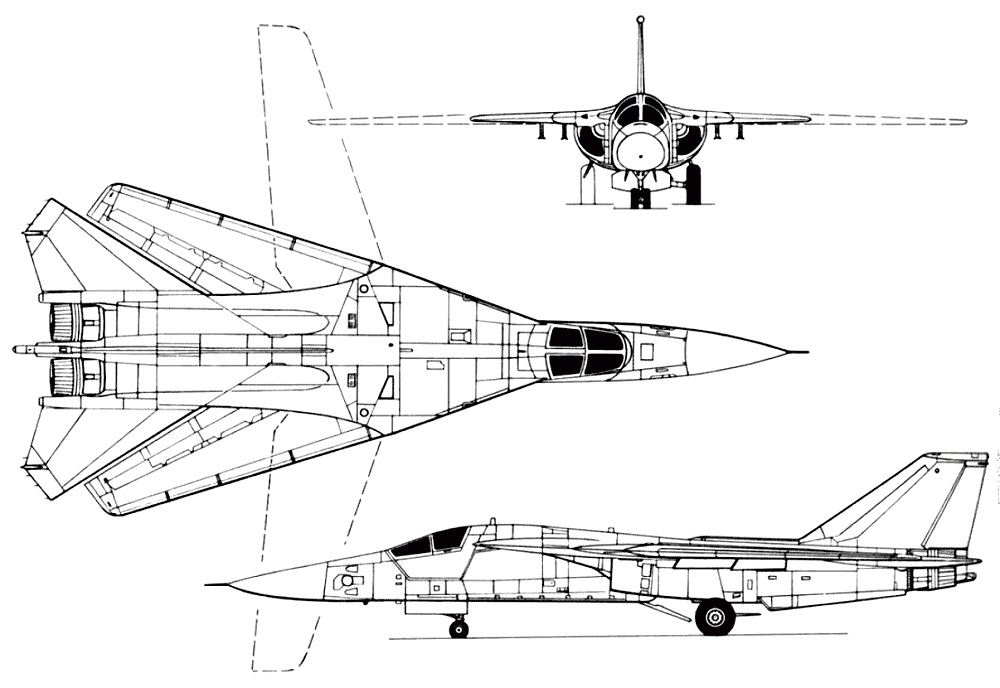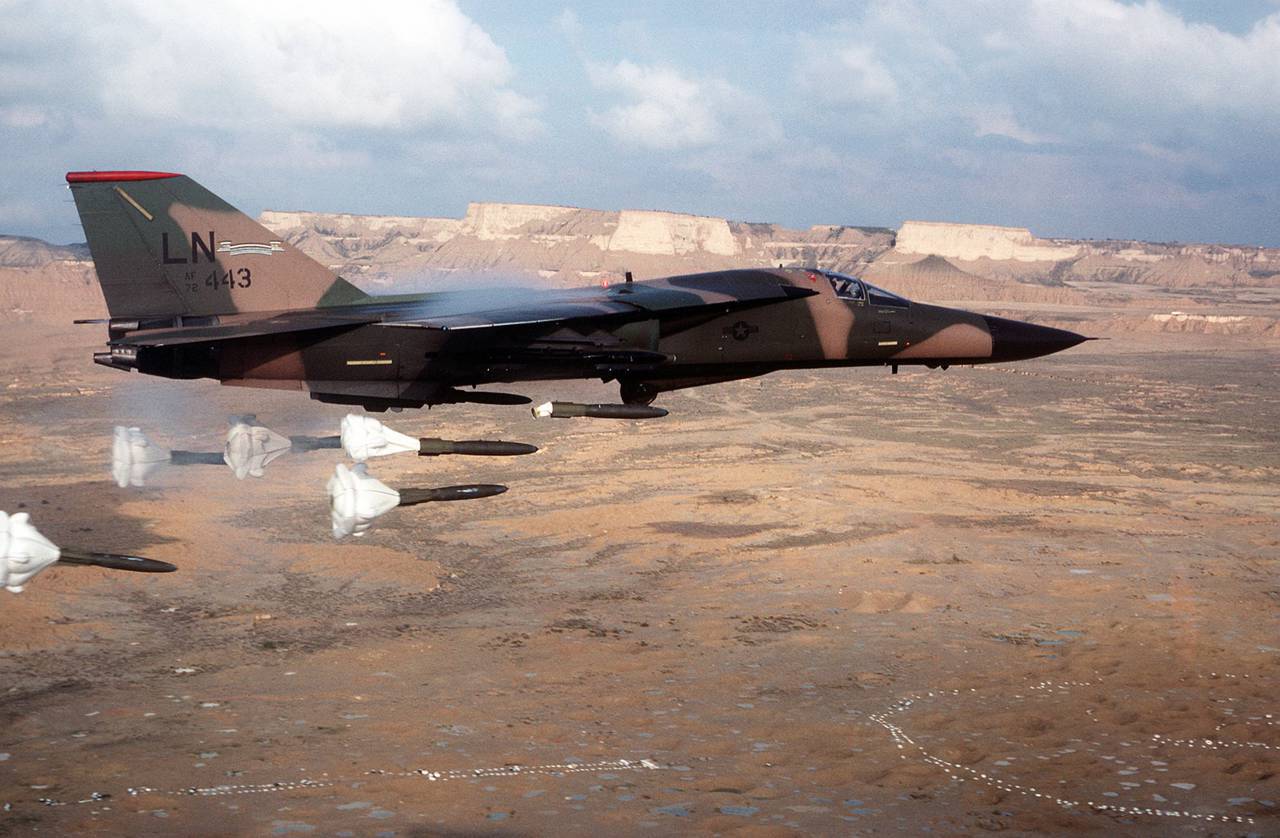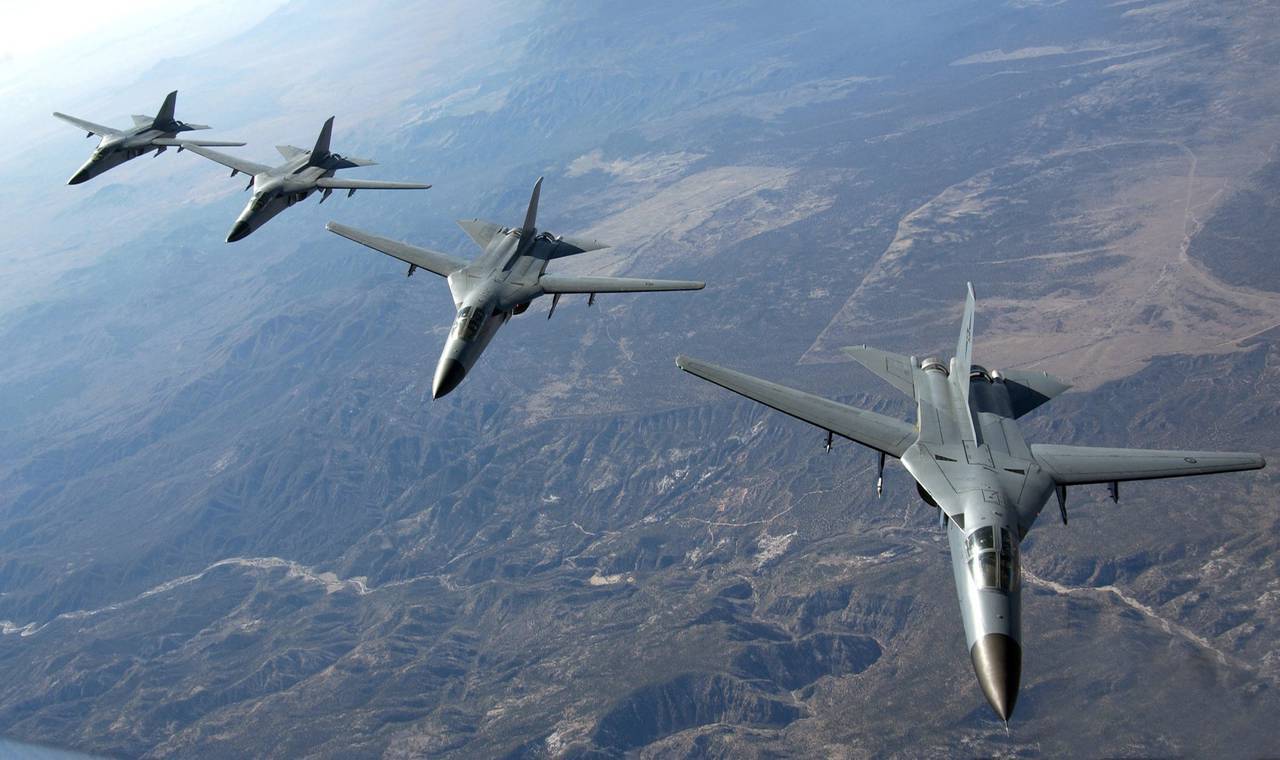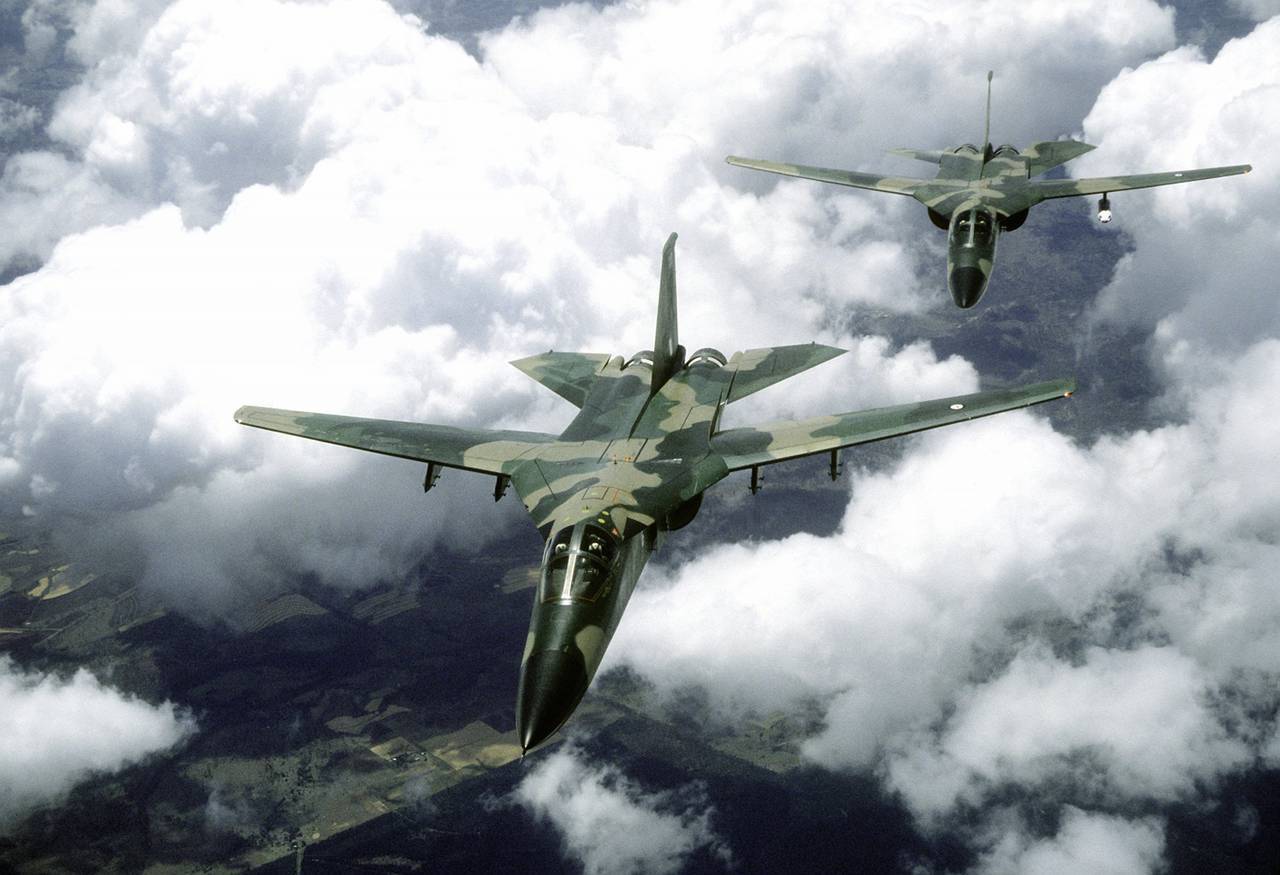TS
mbilung4
F-111 - one of the best in its class
F-111 - one of the best in its class
January 16, 2015
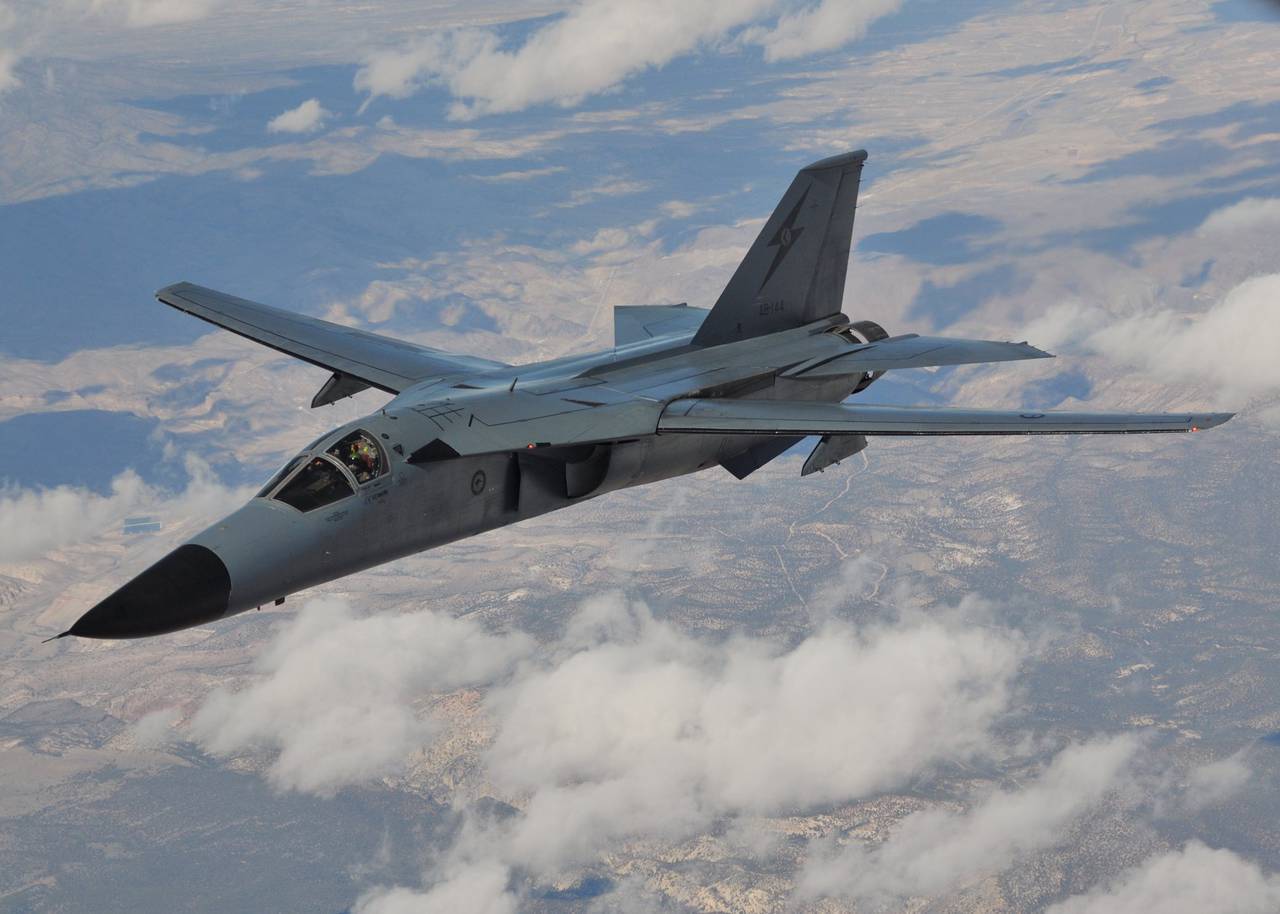
December 21, 1964 the first flight of tactical bomber - the first production aircraft, which has a variable sweep wing. It was a prototype of American tactical bomber F-111. The plane had unofficial names «Aardvark» («aardvark") in the Australian Air Force machine called even more fun «Pig» («Pig"). It so happened that the first swallow and was the most successful. Over the next 50 years, the US defense industry was not able to repeat the success of the F-111 aircraft when creating a variable sweep wing.
In fairness it should be noted that the Soviet defense industry is also not really succeed in this field. After the appearance of the strategic bomber Tu-160 this topic in our country was completely closed. No one tried to get closer to the characteristics of this domestic missile carriers possessing variable sweep wing. There were built 35 giant data (including 8 prototypes), earned the nickname "White Swan", of which 16 are in service with the Russian Air Force.
But back to the middle of the last century. In the late 1950s, the US Air Force Command concluded the need to develop new combat aircraft, which was to change the armed tactical fighter-bomber F-105 "Tanderchif." Already in 1967 adopted the US Air Force entered his replacement - the F-111, which was created by engineers of the company "General Dynamics", who managed to win the competition, the company "Boeing". The aircraft had a set of amazing for its time characteristics.
The thing is that the US military wanted to get combat aircraft, which was supposed to have a set of almost mutually exclusive requirements. They wanted to get the plane carrying capacity bomber, fighter speed and a range of vehicles. They expect to receive the aircraft with good handling at low supersonic speeds and large combat payload and flight range and a small length of the takeoff roll.
Postwar aerodynamics offer no possible compromise. For example, to fly at supersonic speed ideally suited small swept wings and fly at low speeds - low wing sweep and a high aspect ratio. The only possible way out was to move to the wing, which would have a variable geometry in flight. In the late 1950s, variable sweep wing seemed the perfect solution, the benefit to the point in the aircraft industry, new materials and engineering developments that will translate the idea into practice.
When listing the main advantages of US tactical bomber, the F-111, which was built by General Dynamics, in the first place deduce that this is the first worldwide production aircraft with a variable sweep wing. This was an important component of success of the aircraft. But really in the first place should be put on the availability of aircraft radar following the terrain. This feature allowed the F-111 in combat conditions to ignore the attempts to shoot down the plane air defenses, but it is true only up to a certain time.
[spoiler]=2 [/spoiler]
[/spoiler]
Initially, the developers did not think to build aircraft with variable geometry wing, but the growth of the Air Force generals appetites forced the company to turn to extreme measures. This has led to a substantial increase in the cost of the aircraft. In this connection, 2/3 potential buyers news just canceled their application for the aircraft. Engineers from General Dynamics is required to create a machine that combines all-weather fighter-interceptor, bomber, attack, carrier-based aircraft and reconnaissance. The maximum speed of the aircraft was supposed to be 2.5 M, while cruising at a distance of 600 kilometers - 1.2 M. It is fortunate that in the process of development it was decided to abandon the idea of vertical take-off and landing.
But in this case, the plane was to take off from unpaved runways ordinary length of not more than 900 meters, with a combat load of up to 14 tons, and range - 1500 km. Meet all these characteristics, the aircraft with conventional swept wing was not able to. Such a short distance for take-off with a very large weight can be achieved by using a large area of the wing. However, if the wing is flying speed would become strongly inhibited by increasing the drag. For this reason, American designers have implemented the scheme takeoff on "straightened" wing. When approaching the speed of the aircraft to supersonic wing just evolved, and airframe began like a rocket. When making a landing wing again "dealt".
In this case, the main enemy of the new American cars were not even the enemy SAMs, and the earth's surface itself. Up to General Dynamics nobody built these aircraft and not engaged in similar problems. The company's specialists had a lot of work, but research has been spent 2 million man-hours. Another 5,000 hours spent on purging the layout of the aircraft. The entire work is to create a tactical bomber F-111 demanded from General Dynamics engineers 25 million man-hours, and even 31,000 hours purge aircraft in the "tube". The result was a folding wing papers, which turned out to be optimal. For the entire life of the machine, which was quite impressive (the last aircraft was removed from the US Air Force in 1998), the mechanization of the wing has not collected any complaints.
Its first flight prototype of the F-111 performed December 21, 1964, and after 3 months during the flight began to use the swing wings. Built plane turned too expensive, since the end of World War II, it was the most ambitious American project. For the development of this war machine took almost 2 billion dollars. Originally it was planned that the aircraft will cost about $ 3.7 million apiece, but consumers started to get planes in 1967 already priced up to $ 18.3 million per aircraft. It is for this reason it was built only 563 aircraft from 1500 pre-ordered vehicles. Out of the car, which was originally conceived as a multi-role fighter, came out fine all-weather double tactical bomber. From other incarnations machines representatives of the American Air Force and Navy refused.
The appearance of this unusual novelty could not go unnoticed on the other side of the ocean. Soviet response to the tactical bomber F-111 was the creation of Sukhoi Su-24, which is still in service with the Russian Air Force. This aircraft was created within the framework of the T-6. The first option was the plane T-6-1. This machine was created by the type known at that time the English tactical bomber TSR-2, which had a small fixed-wing extension and a trapezoidal shape, wing tips are pointing downwards. However, studies have shown that the more preferable for an aircraft to be variable geometry wing. Created under this scheme the second prototype has already been externally similar to the American F-111. In the USSR, state tests novelty T-6C was completed only in 1975, the same year on February 4 it was decided to adopt the formulation aircraft parts aircraft of the Navy and Air Force.
Operation and disadvantages
At first, the new US tactical bomber is very actively used during the Vietnam War. Primarily through the use of radar that tracked the terrain and allows the aircraft to perform the flight at supersonic speed and ultra-low altitudes. North Vietnamese troops used the Soviet air defense systems S-75 is very good knocks altitude targets, but could not hit the F-111 being flown at an altitude below 500 meters. During the period from 1968 to 1973, a new US aircraft made in Vietnam to 3 thousand sorties.
Mainly F-111A aircraft were used in Vietnam as bombers. At low altitude (up to 60-80 meters) they are offline, follow the goal, rounding terrain. In fact, they were the prototype for future cruise missiles - the intended target coordinates were entered into the onboard computer of the aircraft still on the ground, pilots could only monitor the devices. Even after 40 years, F-111A, according to some experts, is unparalleled on the possibility of making low-level flights by shocks in the rear of the enemy.
In this case, fly at low and ultra low altitudes when pilots fully entrust their fate autopilot, were fraught with many dangers and require them to great tension - the small glitch automation could end in disaster. Not by chance in clubs F-111 pilots were often hung sheets with black humor. The inscriptions on them says: "The effectiveness of SAM does not exceed 15% of flak - 5% of the land - not less than 100%." In fairness it should be noted that the aircraft had a special machine that was in the case of failure of the relief radar display car at the "barrel" with large congestion.
Total in Vietnam Americans lost 5 aircraft F-111. Only two losses are known to have been shot down by the new Soviet air defense systems S-125, which could to capture targets located at a height of 20 meters above the ground. At the same time, three other tactical bombers were lost just because of the failure of high-altitude autopilot.
As the first production car with a variable sweep wing aircraft F-111 had all the "ancestral curses" of this type of aircraft. One of them was the weighting of its design through the use of highly sophisticated mechanisms of transformation of the wing in flight. Also greatly increases the demand for training pilots for this machine. Growing operating costs. But American engineers managed to successfully deal with these shortcomings, and through periodic upgrades to the aircraft remained in service with the US Air Force until 1998. So longevity tactical bombers boast very rare. The main argument for the complete replacement of the F-111 to F-16 became mainly the high cost of manual first.
Later aircraft with variable sweep wing is not particularly popular in America. Total there have been three such serial machines. The second aircraft with variable sweep wing fighter-interceptor was F-14 Tomcat. Its main advantage were not flying qualities, and a modern powerful radar that could lead both 24 goals, as well as high-precision weapons, striking targets at a distance of 180 km, which among other things different prohibitive cost of 500 thousand dollars. In the F-14 Tomcat were very low levels of vitality: of the 478 aircraft that operated in the United States, for various reasons, have been lost 166 machines. In this respect it resembles the Soviet Su-24, which was very difficult to manage and is now considered one of the most damaged cars in the Russian Air Force.
The third American aircraft with variable sweep wing strategic bomber was B-1 Lancer. In terms of the feasibility of establishing this plane looks more like a misunderstanding. Initially, Rockwell produced 4 prototype that can reach speeds of up to 2300 km / h. At this speed, the need actually arises to reduce drag in flight. But then the company has something went wrong, and a top speed of 100 serial bomber B-1B was 1320 km / h. In this case, at this speed would normally show themselves and conventional swept wing.
Flight performance F-111E:
Dimensions: wingspan - 19.2 m (deployed position), 9.47 m (folded position), the wing area - 61.07 m2 (deployed position), 48.77 m2 (folded position), length - 24 m, Height - 5.22 m.
Maximum take-off mass: 45359 kg empty - 21,394 kg of equipment - 37 577 kg.
Powerplant: two turbojet engine Pratt & Whitney TF-30-P-100, maximum thrust 79,6 kN, afterburner - 112 kN.
The mass of fuel (in internal tanks) - 14 700 kg.
A maximum speed - 2655 km / h (M = 2.5).
Landing speed - 200 km / h.
Combat radius of 2140 km, ferry range - 5190 km.
Service ceiling - 17985 m.
Crew - 2 people.
Armament: Hanging multi-lateral gun M61A1 (20 mm) and 2 SD AIM-9P3, combat load - 14,290 kg for 8 hardpoints.
Sources of information:
http://svpressa.ru/post/article/107909/?rintr=1
http://www.militaryparitet.com/vp/45
http://www.popmech.ru/weapon/6534-sa...spektiva/#full
-------------------------------------------------------
FYI
January 16, 2015

December 21, 1964 the first flight of tactical bomber - the first production aircraft, which has a variable sweep wing. It was a prototype of American tactical bomber F-111. The plane had unofficial names «Aardvark» («aardvark") in the Australian Air Force machine called even more fun «Pig» («Pig"). It so happened that the first swallow and was the most successful. Over the next 50 years, the US defense industry was not able to repeat the success of the F-111 aircraft when creating a variable sweep wing.
In fairness it should be noted that the Soviet defense industry is also not really succeed in this field. After the appearance of the strategic bomber Tu-160 this topic in our country was completely closed. No one tried to get closer to the characteristics of this domestic missile carriers possessing variable sweep wing. There were built 35 giant data (including 8 prototypes), earned the nickname "White Swan", of which 16 are in service with the Russian Air Force.
But back to the middle of the last century. In the late 1950s, the US Air Force Command concluded the need to develop new combat aircraft, which was to change the armed tactical fighter-bomber F-105 "Tanderchif." Already in 1967 adopted the US Air Force entered his replacement - the F-111, which was created by engineers of the company "General Dynamics", who managed to win the competition, the company "Boeing". The aircraft had a set of amazing for its time characteristics.
Spoiler for 1:
The thing is that the US military wanted to get combat aircraft, which was supposed to have a set of almost mutually exclusive requirements. They wanted to get the plane carrying capacity bomber, fighter speed and a range of vehicles. They expect to receive the aircraft with good handling at low supersonic speeds and large combat payload and flight range and a small length of the takeoff roll.
Postwar aerodynamics offer no possible compromise. For example, to fly at supersonic speed ideally suited small swept wings and fly at low speeds - low wing sweep and a high aspect ratio. The only possible way out was to move to the wing, which would have a variable geometry in flight. In the late 1950s, variable sweep wing seemed the perfect solution, the benefit to the point in the aircraft industry, new materials and engineering developments that will translate the idea into practice.
When listing the main advantages of US tactical bomber, the F-111, which was built by General Dynamics, in the first place deduce that this is the first worldwide production aircraft with a variable sweep wing. This was an important component of success of the aircraft. But really in the first place should be put on the availability of aircraft radar following the terrain. This feature allowed the F-111 in combat conditions to ignore the attempts to shoot down the plane air defenses, but it is true only up to a certain time.
[spoiler]=2
 [/spoiler]
[/spoiler]Initially, the developers did not think to build aircraft with variable geometry wing, but the growth of the Air Force generals appetites forced the company to turn to extreme measures. This has led to a substantial increase in the cost of the aircraft. In this connection, 2/3 potential buyers news just canceled their application for the aircraft. Engineers from General Dynamics is required to create a machine that combines all-weather fighter-interceptor, bomber, attack, carrier-based aircraft and reconnaissance. The maximum speed of the aircraft was supposed to be 2.5 M, while cruising at a distance of 600 kilometers - 1.2 M. It is fortunate that in the process of development it was decided to abandon the idea of vertical take-off and landing.
But in this case, the plane was to take off from unpaved runways ordinary length of not more than 900 meters, with a combat load of up to 14 tons, and range - 1500 km. Meet all these characteristics, the aircraft with conventional swept wing was not able to. Such a short distance for take-off with a very large weight can be achieved by using a large area of the wing. However, if the wing is flying speed would become strongly inhibited by increasing the drag. For this reason, American designers have implemented the scheme takeoff on "straightened" wing. When approaching the speed of the aircraft to supersonic wing just evolved, and airframe began like a rocket. When making a landing wing again "dealt".
In this case, the main enemy of the new American cars were not even the enemy SAMs, and the earth's surface itself. Up to General Dynamics nobody built these aircraft and not engaged in similar problems. The company's specialists had a lot of work, but research has been spent 2 million man-hours. Another 5,000 hours spent on purging the layout of the aircraft. The entire work is to create a tactical bomber F-111 demanded from General Dynamics engineers 25 million man-hours, and even 31,000 hours purge aircraft in the "tube". The result was a folding wing papers, which turned out to be optimal. For the entire life of the machine, which was quite impressive (the last aircraft was removed from the US Air Force in 1998), the mechanization of the wing has not collected any complaints.
Spoiler for 3:
Its first flight prototype of the F-111 performed December 21, 1964, and after 3 months during the flight began to use the swing wings. Built plane turned too expensive, since the end of World War II, it was the most ambitious American project. For the development of this war machine took almost 2 billion dollars. Originally it was planned that the aircraft will cost about $ 3.7 million apiece, but consumers started to get planes in 1967 already priced up to $ 18.3 million per aircraft. It is for this reason it was built only 563 aircraft from 1500 pre-ordered vehicles. Out of the car, which was originally conceived as a multi-role fighter, came out fine all-weather double tactical bomber. From other incarnations machines representatives of the American Air Force and Navy refused.
The appearance of this unusual novelty could not go unnoticed on the other side of the ocean. Soviet response to the tactical bomber F-111 was the creation of Sukhoi Su-24, which is still in service with the Russian Air Force. This aircraft was created within the framework of the T-6. The first option was the plane T-6-1. This machine was created by the type known at that time the English tactical bomber TSR-2, which had a small fixed-wing extension and a trapezoidal shape, wing tips are pointing downwards. However, studies have shown that the more preferable for an aircraft to be variable geometry wing. Created under this scheme the second prototype has already been externally similar to the American F-111. In the USSR, state tests novelty T-6C was completed only in 1975, the same year on February 4 it was decided to adopt the formulation aircraft parts aircraft of the Navy and Air Force.
Operation and disadvantages
At first, the new US tactical bomber is very actively used during the Vietnam War. Primarily through the use of radar that tracked the terrain and allows the aircraft to perform the flight at supersonic speed and ultra-low altitudes. North Vietnamese troops used the Soviet air defense systems S-75 is very good knocks altitude targets, but could not hit the F-111 being flown at an altitude below 500 meters. During the period from 1968 to 1973, a new US aircraft made in Vietnam to 3 thousand sorties.
Spoiler for 4:
Mainly F-111A aircraft were used in Vietnam as bombers. At low altitude (up to 60-80 meters) they are offline, follow the goal, rounding terrain. In fact, they were the prototype for future cruise missiles - the intended target coordinates were entered into the onboard computer of the aircraft still on the ground, pilots could only monitor the devices. Even after 40 years, F-111A, according to some experts, is unparalleled on the possibility of making low-level flights by shocks in the rear of the enemy.
In this case, fly at low and ultra low altitudes when pilots fully entrust their fate autopilot, were fraught with many dangers and require them to great tension - the small glitch automation could end in disaster. Not by chance in clubs F-111 pilots were often hung sheets with black humor. The inscriptions on them says: "The effectiveness of SAM does not exceed 15% of flak - 5% of the land - not less than 100%." In fairness it should be noted that the aircraft had a special machine that was in the case of failure of the relief radar display car at the "barrel" with large congestion.
Total in Vietnam Americans lost 5 aircraft F-111. Only two losses are known to have been shot down by the new Soviet air defense systems S-125, which could to capture targets located at a height of 20 meters above the ground. At the same time, three other tactical bombers were lost just because of the failure of high-altitude autopilot.
Spoiler for 5:
As the first production car with a variable sweep wing aircraft F-111 had all the "ancestral curses" of this type of aircraft. One of them was the weighting of its design through the use of highly sophisticated mechanisms of transformation of the wing in flight. Also greatly increases the demand for training pilots for this machine. Growing operating costs. But American engineers managed to successfully deal with these shortcomings, and through periodic upgrades to the aircraft remained in service with the US Air Force until 1998. So longevity tactical bombers boast very rare. The main argument for the complete replacement of the F-111 to F-16 became mainly the high cost of manual first.
Later aircraft with variable sweep wing is not particularly popular in America. Total there have been three such serial machines. The second aircraft with variable sweep wing fighter-interceptor was F-14 Tomcat. Its main advantage were not flying qualities, and a modern powerful radar that could lead both 24 goals, as well as high-precision weapons, striking targets at a distance of 180 km, which among other things different prohibitive cost of 500 thousand dollars. In the F-14 Tomcat were very low levels of vitality: of the 478 aircraft that operated in the United States, for various reasons, have been lost 166 machines. In this respect it resembles the Soviet Su-24, which was very difficult to manage and is now considered one of the most damaged cars in the Russian Air Force.
The third American aircraft with variable sweep wing strategic bomber was B-1 Lancer. In terms of the feasibility of establishing this plane looks more like a misunderstanding. Initially, Rockwell produced 4 prototype that can reach speeds of up to 2300 km / h. At this speed, the need actually arises to reduce drag in flight. But then the company has something went wrong, and a top speed of 100 serial bomber B-1B was 1320 km / h. In this case, at this speed would normally show themselves and conventional swept wing.
Spoiler for 6:
Flight performance F-111E:
Dimensions: wingspan - 19.2 m (deployed position), 9.47 m (folded position), the wing area - 61.07 m2 (deployed position), 48.77 m2 (folded position), length - 24 m, Height - 5.22 m.
Maximum take-off mass: 45359 kg empty - 21,394 kg of equipment - 37 577 kg.
Powerplant: two turbojet engine Pratt & Whitney TF-30-P-100, maximum thrust 79,6 kN, afterburner - 112 kN.
The mass of fuel (in internal tanks) - 14 700 kg.
A maximum speed - 2655 km / h (M = 2.5).
Landing speed - 200 km / h.
Combat radius of 2140 km, ferry range - 5190 km.
Service ceiling - 17985 m.
Crew - 2 people.
Armament: Hanging multi-lateral gun M61A1 (20 mm) and 2 SD AIM-9P3, combat load - 14,290 kg for 8 hardpoints.
Sources of information:
http://svpressa.ru/post/article/107909/?rintr=1
http://www.militaryparitet.com/vp/45
http://www.popmech.ru/weapon/6534-sa...spektiva/#full
-------------------------------------------------------
FYI
0
4.7K
2
Thread Digembok
Urutan
Terbaru
Terlama
Thread Digembok
Komunitas Pilihan
